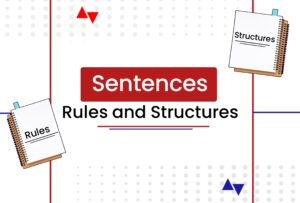Est. reading time: 5 minutes
Sentences are a unit of language that expresses a complete thought or idea. They are the building blocks of communication and come in various forms and structures. This article will explain in detail what a sentence is, the types of sentences, and the rules guiding sentence formation.
What is the definition of a sentence?
In English grammar, a sentence definition is a group of words that show a complete thought. It can also be referred to as a word or clause that communicates a complete message, which could be a command, question, wishful thinking, or exclamation.
Most of the time, sentences have specific structure and a sentence structure involves a sentence having a subject and a predicate (the other part of the sentence without the subject).
A sentence aims to enable a reader or listener to understand the purpose of your statement; hence, a complete thought is conveyed.
Types of Sentences Based on Structure
Based on structure, there are four (4) types of sentences in the English language, and these four sentence types vary with the number of clauses or even the subject-verb group in each.
It is important to pay attention to these four types of sentences to prevent a run-on sentence.
Simple Sentence
A simple sentence in the English language is a sentence that has only one independent clause. They most often contain a subject and a verb.
Here are some simple sentence examples.
- She danced.
- Ella knows how to make a dress.
Based on these two examples, you might be worried about the variation in length. A simple sentence can be short or long, as long as it conveys a complete message.
The important thing you should note when identifying a simple sentence is the number of independent clauses in that sentence.
Compound Sentence
When a sentence connects two independent clauses, it is referred to as a compound sentence. A compound sentence has two independent clauses that are joined together by a comma, semicolon, coordinating conjunction, or transitional expression.
Let’s see some examples.
- I wanted to bring a book, but I forgot.
- The conference is tomorrow; we need to travel down today.
- It is raining; therefore, we can play in the rain.
- She studied all night, yet she felt unprepared for the test.
Complex Sentence
This shares a lot of similarities with compound sentences. It’s a sentence with one independent clause and at least one dependent clause. This means a complex sentence can have more than one dependent clause.
To make the example clear enough, a dependent clause is a clause that cannot stand alone, more like a sentence fragment, while an independent clause can stand alone while making sense.
Example: Though the novel was lengthy, she found it captivating.
Let’s analyse this example: The dependent clause here is “though the novel was lengthy” and this is because it does not make sense on its own.
The independent clause, on the other hand, is “She found it captivating,” because it conveys a meaningful thought on its own.
Compound-Complex Sentence
In a compound-complex sentence, there are two independent clauses and one or more dependent clauses.
Example: While Jane studied for her exams, her brother did the dishes, and their mother prepared dinner.
Let’s make a breakdown of this sentence:
There are two independent clauses in this sentence “Her brother did the dishes” and “Their mother made dinner” The dependent clause in the sentence is “while Jane studied.”
The combination of the two independent clauses and one dependent clause makes up a compound-complex sentence.
Types of Sentences in English Grammar Based on Functions
To ensure sentence clarity, it’s important to understand the types of sentences based on their functions. Likewise, these types of sentences can be differentiated by punctuation marks.
Let’s discuss in detail the 4 types of sentences based on function.
Interrogative Sentences
If you’ve come across a sentence that asks a question demanding an answer and necessitates a question mark, then that is an interrogative sentence.
Interrogative sentences are commonly used in everyday activities when demanding or asking. It asks questions such as why, what, which, when, where, who, whose, whom, and how.
Examples:
- Why is the book here?
- What is your name?
- Which of these is yours?
- When do you eat dinner?
- Where is the car key?
- Who is responsible for organizing the event?
- Whom did you invite to the house yesterday?
- Whose car is that?
- How are you doing today?
Declarative Sentences
This is a sentence that makes a statement, i.e. a sentence that states a fact and communicates information directly.
In a situation where you want to state a fact, opinion, observation, description, or explanation clearly and concisely, you should use a declarative sentence.
Most declarative sentences end with a full stop, and here are a few examples.
- The meeting starts at 9:30 pm tonight.
- The sky is blue.
- Exercise improves mental health.
- Remote work increases productivity.
Imperative Sentences
A command or a polite request is referred to as an imperative sentence.
It usually ends with a full stop and in cases of urgency or emphasis, it ends with an exclamation. The punctuation mark at the end of an imperative sentence is also dependent on the tone and context of the command or request.
Also, imperative sentences can be positive or negative.
Positive Imperative Sentence
A positive imperative sentence is a command or polite request asking to do something. Examples include.
- Sit down.
- Stay focused.
- Keep quiet!
Negative Imperative Sentence
This is just the opposite of a positive imperative sentence, it’s a command asking not to do something.
- Don’t touch the hot iron.
- Don’t open the door.
- Don’t interrupt me!
Exclamatory Sentences
To convey a strong emotion, excitement, surprise, or emphasis, you should use an exclamatory sentence.
An exclamatory sentence shows the intensity of the message conveyed in a sentence, and it’s also used in advertisements.
Examples:
- Wow! This is beautiful.
- That was an incredible performance!
- That’s fantastic!
- Hurry, don’t miss out on this sale!
Sentence Structure and Grammar Rules for Clear Writing
Sentence clarity in writing is important in enabling your reader or listener to understand you better.
We will see some of the sentence structure rules that will help you learn how to write effective sentences in English.
- A sentence must always begin with a capital letter.
- A sentence must end with either a full stop (.), a question mark (?), or an exclamation mark (!) depending on the type of sentence.
- Aside from an imperative sentence, a complete sentence must include a noun and a predicate. i.e. In the case of imperative sentences, only the predicate is important, e.g., “close the door.”
- In the case of a compound sentence, a comma, semicolon, or conjunction must be used to connect independent clauses.
- In a complex sentence, when a dependent clause comes first, the comma should be placed between it and the independent clause. If an independent clause comes first, then no comma is needed.
Conclusion
In conclusion, it is important to remember that sentences are the building blocks of effective communication. Mastering sentence structure and formation can improve your writing and speaking skills, and help us convey your message with clarity.


